It can be rather difficult searching for foods and recipes that don’t make you nauseous during the first trimester, or sometimes even throughout pregnancy. This can be particularly frustrating with the increased feelings of hunger brought about by pregnancy.
In most cases, symptoms of morning sickness can successfully be reduced by consuming a diet rich in nutritious plant foods, and low in processed convenient foods and animal products. There are particular plant-based foods and nutrients that assist with battling morning sickness and nausea throughout pregnancy.
What is morning sickness & what causes it
An estimated 80% of pregnant women experience feelings of nausea between the fourth and seventh week of pregnancy. Fortunately, these uncomfortable symptoms typically resolve by the 20th week of gestation.
The ongoing feelings of queasiness that may or may not lead to vomiting during these infamous initial weeks of pregnancy are generally known as “morning sickness”.
These symptoms are often triggered by certain odors, spicy foods, heat, excess salivation or — oftentimes — no triggers at all.
The cause of morning sickness hasn’t completely been distinguished. One theory is that the hormonal fluctuations experienced throughout pregnancy is the major culprit.
Human chorionic gonadotropin (hCG) is a hormone that spikes particularly during the first trimester. Researchers often attribute this to the discomforts brought about by morning sickness.
Others believe that morning sickness is your body’s response to the foreign DNA molecules constructed by half the chromosomes provided to your baby by the father.
Our body’s natural defenses are trained to reject foreign particles that set up shop where they don’t usually belong. Apparently, a growing fetus is no exception.
There are certain characteristics or risk factors that appear to increase your likelihood of experiencing symptoms of morning sickness, such as if:
- You had nausea or vomiting from motion sickness, migraines, certain smells or tastes, or exposure to estrogen (in birth control pills, for example) before pregnancy
- You had morning sickness during a previous pregnancy
- You’re pregnant with twins or other multiples
These are the risk factors that your doctor will likely go over with you during one of your early prenatal visits.
The dietary role in morning sickness
A less discussed risk factor for morning sickness is diet.
Eating processed, highly refined foods or animal products will cause a cascade of hormonal disturbances in the body, particularly during pregnancy.
An ecological study across 21 countries (Pepper & Craig Roberts, 2006) suggested that high rates of nausea and vomiting during pregnancy are associated with high intakes of meat, milk and eggs, and low intakes of cereals and pulses.
Another study revealed similar results as participants with greater levels of nausea also tended to eat rice and pasta, breakfast cereals, beans and pulses, citrus fruit and fruit juices less frequently, and white bread and soft drinks more frequently.
Several studies found that women with more severe symptoms of morning sickness consumed more soft drinks.
A Finnish study replicated the results of the Southampton Women’s Survey and found that nausea and vomiting during early pregnancy were associated with lower vegetable consumption.
These studies also revealed that women with high levels of nausea and vomiting in early pregnancy were more likely to have a less healthy diet than they had before pregnancy.
This is all great news! As the studies consistently show, morning sickness can be controlled to some extent by choosing healthier foods prior to and during pregnancy.
Naturally reducing morning sickness with dietary changes
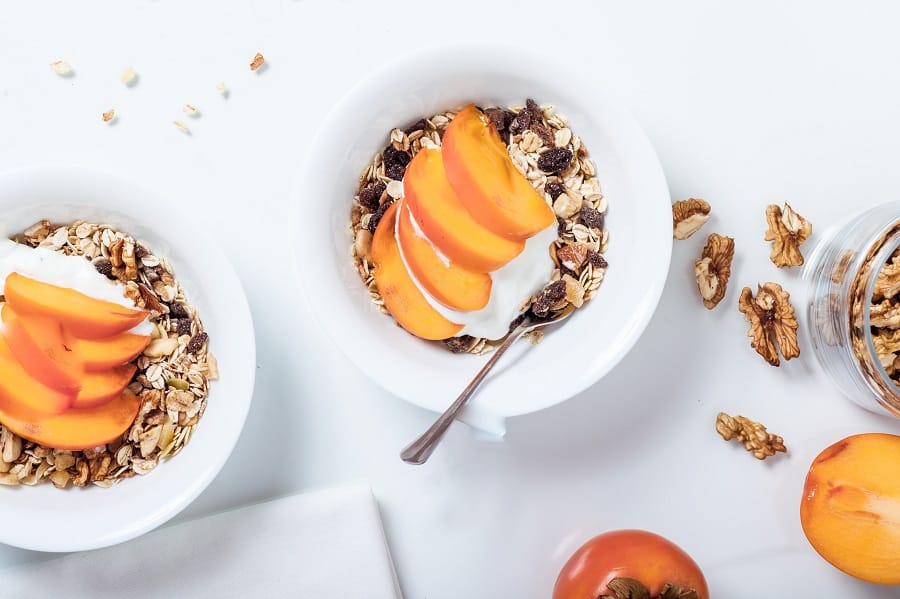
There are two major strategies to reduce morning sickness through your diet:
- Reduce the amount of highly processed, artificially rich foods and animal products in your diet
- Increase the amount of whole plant foods in your diet
Removal or reduction of processed foods
Let’s start with number 1. What exactly do we mean by highly processed, artificially rich foods?
These are plant foods that have been significantly altered in a factory or lab. During processing, they remove the most perishable (and usually most nutritious) components of the plant and leave the desired amount of fat, protein, and carbohydrate behind.
Processing will usually remove healthful components in food such as vitamins, minerals, fiber, phytochemicals, and antioxidants.
Food processors will alter these items further by combining them with additives to increase texture, taste, color, smell, shelf-life, etc.
Basically, the healthiest parts of the plants are removed (in most cases) and combined with harmful additives, such as chemicals, fat, salt, and sugar.
Some examples of these processed items are pastries, commercial cereals, candy, soda, potato chips, frozen dinners, pizza, cake, etc.
If an item in a supermarket contains an ingredients list with more than a few items (particularly ones you do not recognize) you are better off putting it back on the shelf.
These are unnatural, toxic “pseudofoods” that should not be ingested by anyone, especially pregnant women whose bodies utilize the components found in foods to build a fetus.
Removal or reduction of animal foods
Animal products can be just as harmful to the unborn baby as highly processed pseudofoods (if not more so).
These items may provide varying amounts of essential nutrients such as iron, calcium, B12, and omega-3s.
When obtaining these nutrients from animal foods, however, you are stuck with the subsequent toxins they provide.
Things such as high concentrations of environmental contaminants that have accumulated in the animal’s fat stores throughout their lifetime, preservatives, chemical additives, antibiotics, saturated fat, cholesterol, and unnatural amounts of salt, sugar, and fat.
Conversely, when you obtain these essential nutrients from whole, natural plant foods you acquire the nutrients without all the added health risks.
For instance, plants are almost completely devoid of saturated fat (with few exceptions such as avocados and coconuts), cholesterol, chemical additives, antibiotics, and the rest of the harmful additives listed above.
Yes, plants do contain some degree of pesticide contamination. But this can be overcome by purchasing organic produce.
The benefits of consuming plant foods contaminated with pesticides greatly out-weigh the risks of abstaining from eating all plants due to such contamination.
For a full scientific review on this topic feel free to visit earlier articles I completed, such as Plant-based Pregnancy: Insider How-tos, Benefits, & Myths, Why a Plant-based Diet is Healthier than Eating Meat, Plant-based, Vegan Diet Vs Paleo: Which is healthier?, and Is it Really Healthy or Safe to Feed Your Baby Cow’s Milk?
Replenishing your diet with nutritious plant foods

The second major strategy to reduce uncomfortable symptoms of morning sickness includes replacing those processed, harmful foods with whole, nutritious plant foods.
Unlike processed and animal foods, plants are rich in healthful components that will ease your morning sickness and provide your developing baby with much needed nutrition.
For example, plants contain more abundant and diverse micronutrient distributions than animal foods. You are also obtaining these essential nutrients directly from the source instead of feeding the plants to the animals and then eating the animals, for instance.
Some other healthful components uniquely found in plant foods are fiber, prebiotics, probiotics, phytochemicals, antioxidants, sterols, and stanols.
This list is far from comprehensive because there are so many additional health benefits discovered about the consumption of plant materials every day.
For more information on the benefits of consuming a plant-based diet click on the link to view either of my earlier submissions listed here: 14 Major Myths & Misconceptions Surrounding a Plant-based, Vegan Diet, 12 Top Benefits of a Plant-based, Vegan Diet.
There is much we still have yet to understand about how the components found in plant foods interact with our cells and tissues to create health and vitality.
The main food groups in your regular diet should be fruit, vegetables, whole grains, legumes, nuts, and seeds. Foods like rice, potatoes, spinach, broccoli, berries, and beans should be your focus.
If you absolutely cannot part with the refined foods or animal products 100% during pregnancy, then be sure to use them as condiments or reserve for special occasions.
The more whole plant foods in your diet the less room you will have for the harmful items, and the less likely you will suffer from severe morning sickness.
You can transition your dietary patterns slowly or all at once depending on your personality.
For instance, I’m an all-or-nothing kind of girl, so I dove headfirst into this style of living and in doing so, I have been able to reap the benefits more quickly and more noticeably.
In turn, this makes it easier to stick with the diet because you are more motivated by the visible results.
For a full in-depth guide on how to transition to a plant-based or vegan diet click on the link to be sent to my earlier article Complete Guide for Starting a Plant-Based, Vegan Diet.
Also use this link to view a sample grocery list to help you get started right away: Printable Plant-based SOS & Gluten-free Grocery List & Tips!
Best foods & nutrients for battling morning sickness
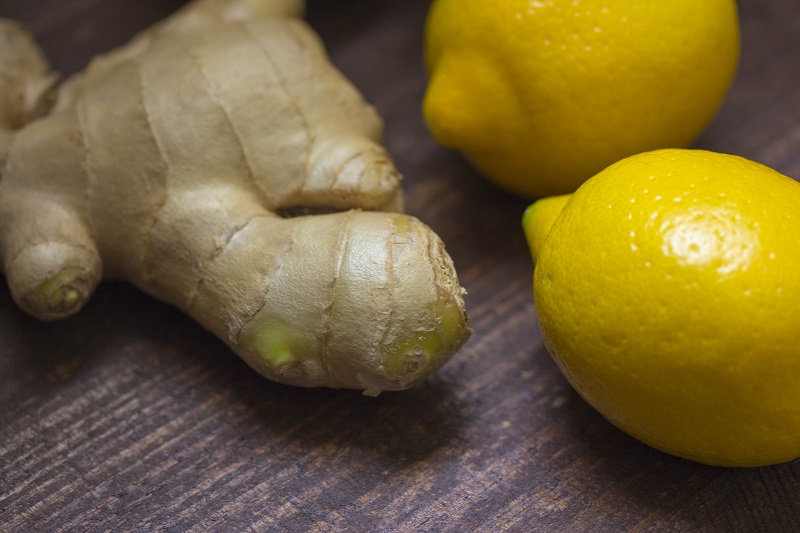
Certain foods and nutrients have been shown to significantly improve the nausea and vomiting associated with early pregnancy.
The recipes found at the end of this article will incorporate each of the following components: Vitamin B6, fiber, bland low-fat, high carb foods, and ginger.
Vitamin B6
Vitamin B6 (pyroxidine) has been proven to safely and effectively alleviate uncomfortable symptoms of morning sickness for many women.
It is not a coincidence that this vitamin is found abundantly in vegan diets that focus on whole plant foods.
Vegetables, fruits, whole grains, nuts, seeds, and legumes are all rich in vitamin B6.
Some examples of these foods include:
- pistachios
- carrots
- spinach
- bananas
- avocados
- chia seeds
- soybeans
- kale
- potatoes
- walnuts
- whole grains
- zucchini
The recommended intake for B6 during pregnancy is 1.9 mg per day.
Higher recommendations of 10 mg taken three times per day for up to 5 days has been proven to significantly reduce symptoms associated with morning sickness.
Be sure to check with your doctor, OBGYN, or midwife prior to starting this regimen.
The safest way to get your vitamin B6 is to consume the nutrient rich foods listed above. The recipes below also include many of these options to ensure adequate amounts of this vitamin.
Fiber
Eating fiber rich foods is especially important during pregnancy.
Vegans reportedly experience fewer symptoms of nausea and vomiting during their first trimester. Fiber may have a lot to do with this statistic.
This indigestible substance may help ward off morning sickness for several reasons.
For instance, fiber aids in digestion and allows for regular bowel movements. You certainly don’t want fecal matter hanging out and fermenting in your lower intestine longer than necessary.
This alone can increase feelings of queasiness by crowding your organs and excreting unwanted toxins into your bloodstream.
Fiber helps to move offending foods through the digestive tract.
Fiber also has been shown to pull extra estrogen out of the blood. Excess estrogen has long been theorized as one of the major causes of morning sickness.
Bland low-fat, high carbohydrate foods
During the first trimester, some women report cravings for bland, dry, high carbohydrate rich foods.
Items such as crackers, bread, cereal, rice cakes, and granola fall into this description.
Bland foods are thought to be more acceptable for consumption while experiencing nausea because they do not posses much of an odor.
Odors, of course, can be what triggers the nausea for most people.
Low-fat, high-carb foods tend to pass rapidly through the stomach for quick and easy digestion. This allows for less time to experience feelings of queasiness.
This is also helpful for consuming smaller, more frequent meals throughout the day.
When your body doesn’t have to focus a lot of energy on digestion you will feel more alert and energized.
Ginger
You simply cannot write about morning sickness without including ginger.
This is a time-honored remedy for feelings of nausea and queasiness during those first few months of pregnancy.
Researchers have found that the benefits of ginger are apparent regardless of the amount that the women take or how the ginger is prepared (powdered fresh root, tablets, capsules, or syrup).
Ginger can provide relief in the form of cookies, teas, preserves, powder, capsules, and ginger ale.
Although some versions of these ginger foods are healthier than others, it is important to find effective options to assist in keeping food down.
Start with the herbal organic ginger teas and any foods you have prepared with fresh ginger. The less you process this root vegetable the more its beneficial health components will be preserved.
If these options don’t work, I would suggest trying the capsules. These inevitably provide the quickest digestion and least amount of flavor, as well as odor.
Healthy vegan recipes for reducing morning sickness
The following recipes have been constructed with new mommies in mind. Each item is packed with vitamin B6, ginger, fiber, is low in fat, and high in carbohydrates to reduce uncomfortable symptoms of nausea and queasiness.
These recipes were also developed to include foods in their most whole, intact form to provide the highest integrity of nutrients.
The following foods are free from gluten, salt, sugar, oil, dairy, and other animal products to provide the healthiest options on your pregnancy journey. Enjoy!
Chamomile Ginger Lemon Raw Energy Bars
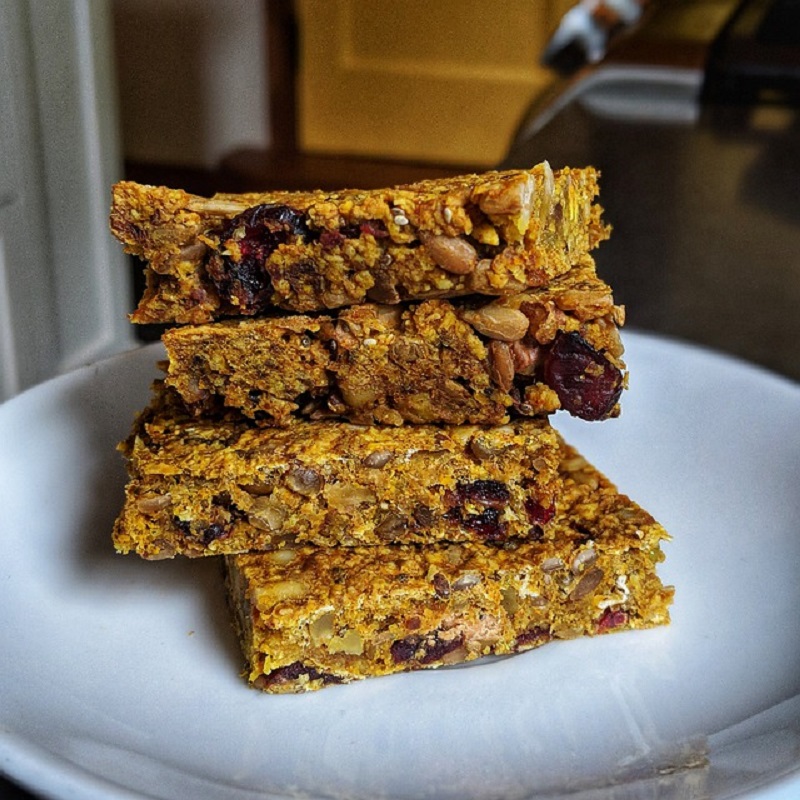
Ingredients:
- 1/2 cup cashews
- 1/2 cup walnuts
- 1 1/4 cup dates or dried apricots
- 2 tablespoons ground flaxseed
- 1 tablespoon dried chamomile
- 1 tablespoon freshly grated ginger
- Juice of 1/2 lemon
- 2 teaspoons vanilla extract
Instructions:
Place nuts, dried fruit, and flax seeds into a food processor or blender and blend until chopped up and combined.
Add in rest of ingredients until thoroughly fused.
Form into whatever shapes that you prefer.
Store in an airtight container in refrigerator for up to 5 days.
Compliments of OneGreenPlanet.org
Easy Vegetable Bean Soup
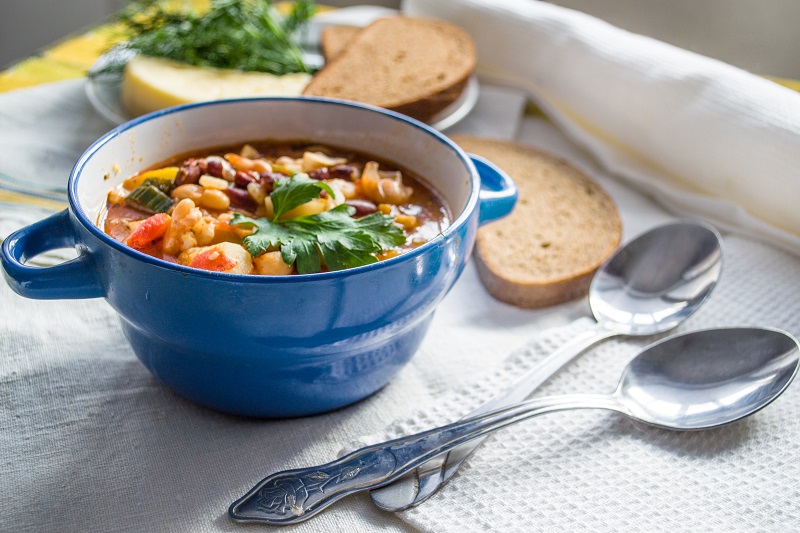
Ingredients:
- 2 cups pre-soaked navy beans
- 2 cups pre-soaked kidney beans
- 1 cup spinach, chopped
- 1 cup cabbage, chopped
- 1 cup okra, chopped
- 1 medium red onion, diced
- 2 medium carrots, diced
- 4 medium red potatoes, cubed
- 4 garlic cloves, minced or finely chopped
- 2 tbs ginger, finely grated
- 1 tbsp cumin
- 1 tbsp onion powder
- 1 tbsp garlic powder
- 1 tbsp turmeric powder
Instructions:
Throw all the ingredients in a pressure cooker. Use the soup setting or approximately 35 minutes for the manual setting.
Let the soup simmer for several hours in cooker after pressure has been released.
Strain and blend in a food processor or blender if the consistency is too difficult on your queasy tummy.
Add 1 tsp red pepper flakes for some added spice if desired.
Freeze any soup that has not been consumed after the first 4 days.
You can also consume this cold if that is easier with your morning sickness symptoms. Try with a slice of Ezekiel bread.
If you do not own a pressure cooker, you can cook most of the ingredients together in a large pot on medium heat for about 20 minutes. Then add the spinach and cabbage last, and simmer for another hour or two.
Classic gingerbread loaf
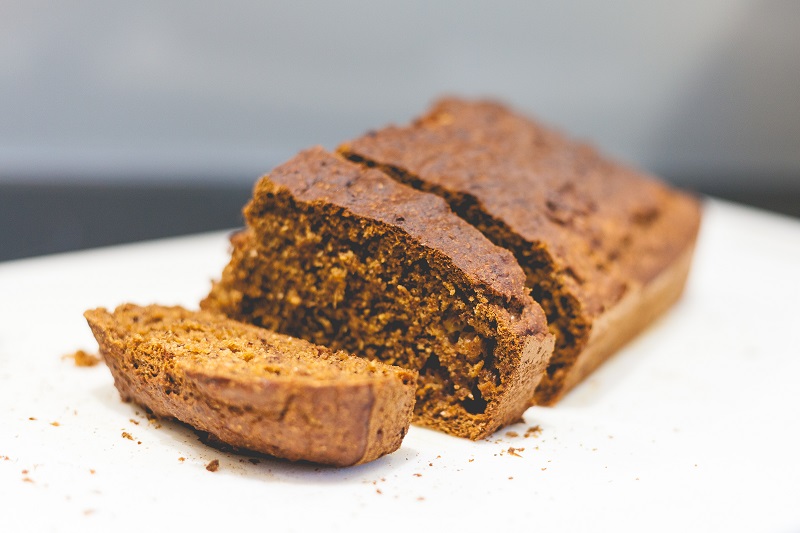
Ingredients:
- 2 cups oat or cassava flour
- 1 teaspoon baking soda
- 1 and 1/2 teaspoons ground ginger
- 1 and 1/2 teaspoons ground cinnamon
- 1/4 teaspoon ground cloves
- 1/2 cup blackstrap molasses
- 1/3 cup soy or almond milk
- 1/4 cup pure maple syrup
- 1/3 cup applesauce
- 3/4 cup hot water
- 1 teaspoon pure vanilla extract
Instructions:
Preheat the oven to 350°F. Then line a 9 x 5″ loaf pan with parchment paper, or use a silicone baking pan.
In a large bowl, combine the flour, baking soda, ginger, cinnamon, and cloves. Whisk together then set aside.
In a separate bowl, combine the molasses, maple syrup, applesauce, plant milk, and vanilla extract. Whisk together.
Add the dry ingredients to the bowl with the wet ingredients then fold together with a spatula a few times.
Pour in the hot water then stir until everything is well combined. Pour the batter into the loaf pan.
Bake in the oven for 60 minutes, until set. Allow to cool for at least 15 minutes.
Recipe inspired by MakingThymeForHealth.com
Apple carrot muffins
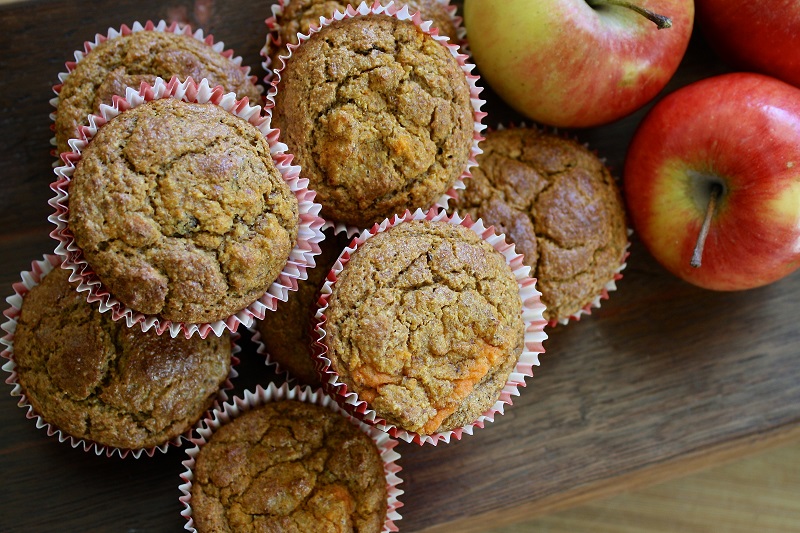
Ingredients:
- 1 1/2 batches of flax eggs (Mix 1 1/2 Tbsp ground flax seed to 4 Tbsp (60 ml) water)
- 1/3 cup very ripe banana, mashed
- 1/4 maple syrup
- 1/2 cup unsweetened applesauce (or finely grated apple)
- 1/4 pitted Medjool dates (soaked and well blended) or use date paste or blackstrap molasses
- 1 1/2 tsp baking soda
- 1/2 tsp ground cinnamon
- 1/2 tsp ground cloves
- 1/2 tsp nutmeg
- 3/4 cup unsweetened almond milk
- 1 heaping cup (packed) finely grated carrot
- 2/3 cup gluten-free rolled oats
- 1/2 cup almond flour
- 1 cup cassava or oat flour
- 1/4 cup raw walnuts (chopped for topping)
Instructions:
Prepare flax eggs in a large mixing bowl and preheat oven to 375° F (190° C).
Prepare muffin tin with liners or use silicone muffin sheet.
To flax eggs, add mashed banana, maple syrup, blended dates*, and almond milk. Whisk to combine.
Next add applesauce, baking soda, cinnamon, ground cloves, and nutmeg and whisk to combine.
Add grated carrot and stir.
Add oats, almond flour, and cassava flour and stir.
Divide evenly among 12 muffin tins, filling them all the way up to the top, and top with crushed walnuts (optional).
Bake for 30-35 minutes, or until deep golden brown and a toothpick inserted into the center comes out clean.
Remove from oven and let set in the pan for 15 minutes.
Once cooled, store in a covered container or bag at room temp to keep fresh. Freeze after that to keep fresh.
Makes 12 muffins
*For blended dates, soak in almond milk for 3 hours then blend together well.
Compliments of MinimalistBaker.com
Coconut ginger smoothie

Ingredients:
- 1/4 cup dried (unsweetened) coconut flakes
- 1 frozen banana (remove the peel before freezing)
- 1 cup of coconut water
- 3 ice cubes
- 1 Tablespoon fresh ginger, chopped
Instructions:
Blend all ingredients in a blender until smooth. Serve immediately.
Makes one serving.
Compliments of OneGreenPlanet.org

